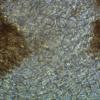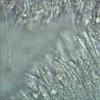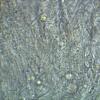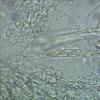
11-11-2025 20:16
Bohan JiaHi, lastly I have found these tiny yellow decayin

09-11-2025 13:20
Hello.A tiny ascomycete, appearing as erupting gra

08-11-2025 00:29
 Francois Guay
Francois Guay
I found this species in Quebec, Canada, on herbace

04-11-2025 09:07
Hello.A suspected Hymenoscyphus sprouting on a thi

04-11-2025 12:43
 Edvin Johannesen
Edvin Johannesen
Hi! One more found on old Populus tremula log in O

.. found on August, 15th, in the Bavarian Forest, on leaves of Fagus silvatica at the base of a collected Lactarius subdulcis. My first thought was Pycnopeziza pachyderma, but this does not fit.
The excipulum is of dark globulosa, and there is no vacuolar body but more guttulate contents.
Unfortunately, the macrofoto is very poor, and the docu of the micros is not very appropriate, too.
Can somebody help anyway?
The asci are with croziers, and the IKI-reaction is blue, but not very strong.
Best regards from Lothar

also anhand deiner Skalenangaben komme ich auf Sporen von 9.5-12.5 x 3.7-4.3 µm.
Das muss die Mollisia spectabilis sein, wobei das natürlich keine Mollisia ist. Der Apikalring sollte vom Hymenoscyphus-Typ sein.
Ich hab den im Cudoniella-Ordner.
Gruß
Zotto

Hallo Zotto,
vielen Dank für Deinen Art-Tipp. Ja, es ist auf alle Fälle keine Mollisia, sie hat keinen Vakuolenkörper. Die von Dir ermittelten Sporen liegen ja in etwa bei dem, was ich auch gemessen habe (auf einem Foto sind ja 2 Sporen gemessen).
Herzliche Grüße von Lothar

Das ist was Seltenes und ist leider noch nie sequenziert worden, soweit ich weiß.

Hallo Zotto,
ein kleiner Beleg wurde angefertigt - viel Material war es ja nicht. Eine Sequenzierung kann und wird vielleicht auch im Rahmen des Projektes statt finden.
Der Becherling war noch ziemlich unreif, und die einzigen Sporen, die ich fand, waren ja noch im Schlauch. Insofern wundern mich die etwas kleinen Sporenmaße nicht so.
LG von Lothar







